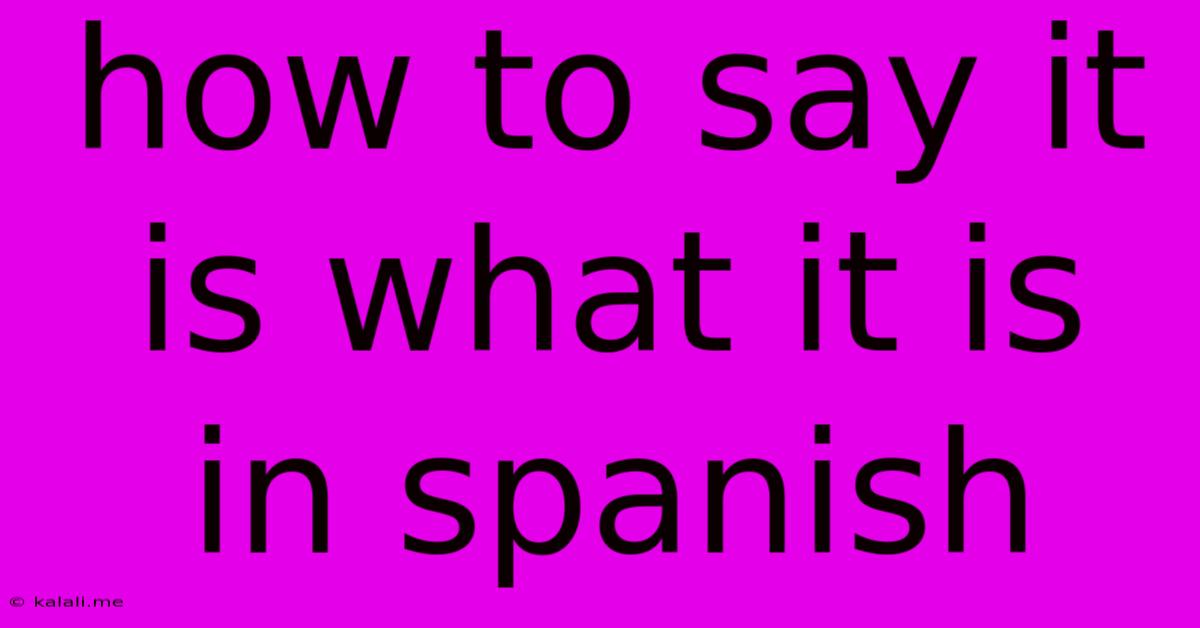How To Say It Is What It Is In Spanish
Kalali
Jun 06, 2025 · 3 min read

Table of Contents
How to Say "It Is What It Is" in Spanish: More Than Just a Literal Translation
The English phrase "it is what it is" conveys a sense of resignation, acceptance, and sometimes even a touch of fatalism in the face of an unchangeable situation. A direct translation into Spanish won't quite capture the nuance, so let's explore several ways to express this sentiment, each with its own subtle shades of meaning. This guide will help you choose the best option depending on the context.
Meta Description: Learn how to say "It is what it is" in Spanish. This guide explores several nuanced translations, helping you choose the perfect phrase to convey resignation, acceptance, or fatalism in different situations.
Understanding the Nuances
Before diving into the translations, it's crucial to understand that the feeling behind "it is what it is" is more important than a word-for-word equivalent. The best translation will depend on the specific situation and the emotion you want to convey. Is it a quiet acceptance? A weary shrug of the shoulders? Or a more forceful acknowledgment of reality?
Common Spanish Translations and Their Contexts
Here are several options, along with explanations of when to use them:
-
Así es la vida.This translates to "That's life" or "Such is life." This is a very common and versatile phrase that expresses resignation to the realities of life, often implying that difficult situations are simply part of the human experience. It's a classic choice for conveying a gentle acceptance. It's perfect for situations where the problem is fairly minor and acceptance is the best path. -
Es lo que es.This is a literal translation of "It is what it is." While grammatically correct, it might sound a little stiff or unnatural to a native speaker. Use this cautiously, perhaps only when you want to emphasize a direct translation for a particular reason. It lacks the emotional weight of other options. -
Ya está.This translates to "It's done," "That's it," or "It is what it is." This phrase carries a sense of finality and closure. It implies that the situation is irreversible and further discussion is pointless. Use this when the situation is concluded and further action is unnecessary. -
Que se le va a hacer.This translates roughly to "What can you do?" or "What's to be done?" This expresses helplessness and resignation, emphasizing that there's nothing one can do to change the situation. Use this when faced with a challenge beyond your control. -
No hay más que hablar.This means "There's nothing more to say." It's used to conclude a discussion where further debate is futile. It conveys a sense of finality and acceptance of the current situation. This is useful when you want to end a conversation that’s gone nowhere.
Choosing the Right Phrase
The best translation of "it is what it is" in Spanish depends entirely on the context. Consider the following factors:
- The severity of the situation: Is it a minor inconvenience or a significant hardship?
- Your emotional state: Are you resigned, frustrated, or simply accepting?
- The audience: Who are you speaking to? A formal setting might call for a more polite and less expressive phrase.
By carefully considering these factors, you can choose the most appropriate and impactful translation to accurately convey the meaning of "it is what it is" in Spanish. Remember, effective communication relies on conveying the feeling as much as the literal meaning.
Latest Posts
Latest Posts
-
Can I Take Pmp Without Project Management Experience
Jun 06, 2025
-
Can U Mix Green And Orange Antifreeze
Jun 06, 2025
-
When An Unclean Spirit Goes Out Of A Man
Jun 06, 2025
-
Saying For What Your Doing Something But Blaming Someone Else
Jun 06, 2025
-
How Did Charlotte Richards Die In Lucifer First Time
Jun 06, 2025
Related Post
Thank you for visiting our website which covers about How To Say It Is What It Is In Spanish . We hope the information provided has been useful to you. Feel free to contact us if you have any questions or need further assistance. See you next time and don't miss to bookmark.